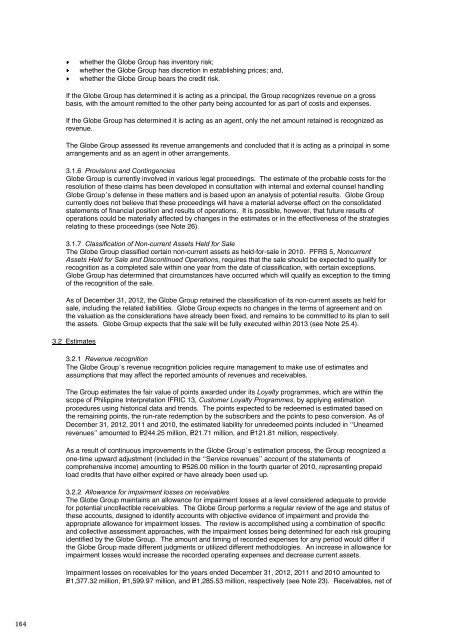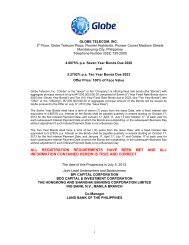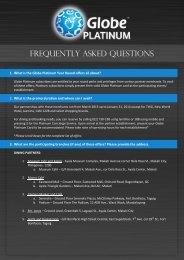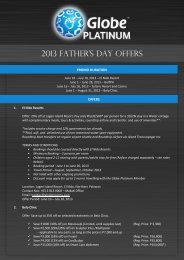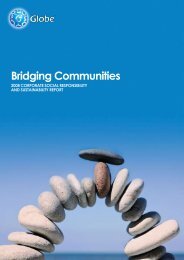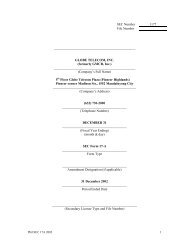here - Ayala
here - Ayala
here - Ayala
You also want an ePaper? Increase the reach of your titles
YUMPU automatically turns print PDFs into web optimized ePapers that Google loves.
Globe 2012 annual report<br />
financial report<br />
whether the Globe Group has inventory risk;<br />
whether the Globe Group has discretion in establishing prices; and,<br />
whether the Globe Group bears the credit risk.<br />
If the Globe Group has determined it is acting as a principal, the Group recognizes revenue on a gross<br />
basis, with the amount remitted to the other party being accounted for as part of costs and expenses.<br />
If the Globe Group has determined it is acting as an agent, only the net amount retained is recognized as<br />
revenue.<br />
The Globe Group assessed its revenue arrangements and concluded that it is acting as a principal in some<br />
arrangements and as an agent in other arrangements.<br />
3.1.6 Provisions and Contingencies<br />
Globe Group is currently involved in various legal proceedings. The estimate of the probable costs for the<br />
resolution of these claims has been developed in consultation with internal and external counsel handling<br />
Globe Group’s defense in these matters and is based upon an analysis of potential results. Globe Group<br />
currently does not believe that these proceedings will have a material adverse effect on the consolidated<br />
statements of financial position and results of operations. It is possible, however, that future results of<br />
operations could be materially affected by changes in the estimates or in the effectiveness of the strategies<br />
relating to these proceedings (see Note 26).<br />
3.1.7 Classification of Non-current Assets Held for Sale<br />
The Globe Group classified certain non-current assets as held-for-sale in 2010. PFRS 5, Noncurrent<br />
Assets Held for Sale and Discontinued Operations, requires that the sale should be expected to qualify for<br />
recognition as a completed sale within one year from the date of classification, with certain exceptions.<br />
Globe Group has determined that circumstances have occurred which will qualify as exception to the timing<br />
of the recognition of the sale.<br />
As of December 31, 2012, the Globe Group retained the classification of its non-current assets as held for<br />
sale, including the related liabilities. Globe Group expects no changes in the terms of agreement and on<br />
the valuation as the considerations have already been fixed, and remains to be committed to its plan to sell<br />
the assets. Globe Group expects that the sale will be fully executed within 2013 (see Note 25.4).<br />
3.2 Estimates<br />
3.2.1 Revenue recognition<br />
The Globe Group’s revenue recognition policies require management to make use of estimates and<br />
assumptions that may affect the reported amounts of revenues and receivables.<br />
The Group estimates the fair value of points awarded under its Loyalty programmes, which are within the<br />
scope of Philippine Interpretation IFRIC 13, Customer Loyalty Programmes, by applying estimation<br />
procedures using historical data and trends. The points expected to be redeemed is estimated based on<br />
the remaining points, the run-rate redemption by the subscribers and the points to peso conversion. As of<br />
December 31, 2012, 2011 and 2010, the estimated liability for unredeemed points included in “Unearned<br />
revenues” amounted to P=244.25 million, P=21.71 million, and P=121.81 million, respectively.<br />
As a result of continuous improvements in the Globe Group’s estimation process, the Group recognized a<br />
one-time upward adjustment (included in the “Service revenues” account of the statements of<br />
comprehensive income) amounting to P=526.00 million in the fourth quarter of 2010, representing prepaid<br />
load credits that have either expired or have already been used up.<br />
3.2.2 Allowance for impairment losses on receivables<br />
The Globe Group maintains an allowance for impairment losses at a level considered adequate to provide<br />
for potential uncollectible receivables. The Globe Group performs a regular review of the age and status of<br />
these accounts, designed to identify accounts with objective evidence of impairment and provide the<br />
appropriate allowance for impairment losses. The review is accomplished using a combination of specific<br />
and collective assessment approaches, with the impairment losses being determined for each risk grouping<br />
identified by the Globe Group. The amount and timing of recorded expenses for any period would differ if<br />
the Globe Group made different judgments or utilized different methodologies. An increase in allowance for<br />
impairment losses would increase the recorded operating expenses and decrease current assets.<br />
Impairment losses on receivables for the years ended December 31, 2012, 2011 and 2010 amounted to<br />
P=1,377.32 million, P=1,599.97 million, and P=1,285.53 million, respectively (see Note 23). Receivables, net of<br />
allowance for impairment losses, amounted to P=12,105.44 million, P=10,119.51 million, and<br />
P=8,374.12 million as of December 31, 2012, 2011 and 2010, respectively (see Note 4).<br />
3.2.3 Obsolescence and market decline<br />
The Globe Group, in determining the NRV, considers any adjustment necessary for obsolescence which is<br />
generally provided 100% for nonmoving items after a certain period. The Globe Group adjusts the cost of<br />
inventory to the recoverable value at a level considered adequate to reflect market decline in the value of<br />
the recorded inventories. The Globe Group reviews the classification of the inventories and generally<br />
provides adjustments for recoverable values of new, actively sold and slow-moving inventories by reference<br />
to prevailing values of the same inventories in the market.<br />
The amount and timing of recorded expenses for any period would differ if different judgments were made<br />
or different estimates were utilized. An increase in allowance for obsolescence and market decline would<br />
increase recorded operating expenses and decrease current assets.<br />
Inventory obsolescence and market decline for the years ended December 31, 2012, 2011 and 2010<br />
amounted to P=170.68 million, P=237.92 million, and P=42.12 million, respectively (see Note 23).<br />
Inventories and supplies, net of allowances, amounted to P=2,076.18 million, P=1,911.19 million, and<br />
P=1,839.33 million as of December 31, 2012, 2011 and 2010, respectively (see Note 5).<br />
3.2.4 ARO<br />
The Globe Group is legally required under various contracts to restore leased property to its original<br />
condition and to bear the costs of dismantling and deinstallation at the end of the contract period. These<br />
costs are accrued based on an in-house estimate, which incorporates estimates of asset retirement costs<br />
and interest rates. The Globe Group recognizes the present value of these obligations and capitalizes the<br />
present value of these costs as part of the balance of the related property and equipment accounts, which<br />
are being depreciated and amortized on a straight-line basis over the EUL of the related asset or the lease<br />
term, whichever is shorter.<br />
The present value of dismantling costs is computed based on an average credit-adjusted risk-free rate of<br />
6.85%, 6.98%, and 9.27% in 2012, 2011 and 2010, respectively. Assumptions used to compute ARO are<br />
reviewed and updated annually.<br />
The amount and timing of recorded expenses for any period would differ if different judgments were made<br />
or different estimates were utilized. An increase in ARO would increase recorded operating expenses and<br />
increase noncurrent liabilities.<br />
The Globe Group updated its assumptions on timing of settlement and estimated cash outflows arising from<br />
ARO on its leased premises. As a result of the changes in estimates, the Globe group adjusted downward<br />
its ARO liability (included under “Other long-term liabilities” account) by P=25.53 million, P=1.64 million, and<br />
P=64.45 million in 2012, 2011 and 2010 against the book value of the assets on leased premises<br />
(see Note 15).<br />
As of December 31, 2012, 2011 and 2010, ARO amounted to P=1,594.63 million, P=1,476.60 million, and<br />
P=1,341.53 million, respectively (see Note 15).<br />
3.2.5 EUL of property and equipment, investment property and intangible assets<br />
Globe Group reviews annually the EUL of these assets based on expected asset utilization as anchored on<br />
business plans and strategies that also consider expected future technological developments and market<br />
behavior. It is possible that future results of operations could be materially affected by changes in these<br />
estimates brought about by changes in the factors mentioned.<br />
A reduction in the EUL of property and equipment, investment property and intangible assets would<br />
increase the recorded depreciation and amortization expense and decrease noncurrent assets.<br />
The EUL of property and equipment of the Globe Group are as follows:<br />
Years<br />
Telecommunications equipment:<br />
Tower 20<br />
Switch 7 and 10<br />
Outside plant, cellsite structures and improvements 10-20<br />
Distribution dropwires and other wireline assets 2-10<br />
164 165


